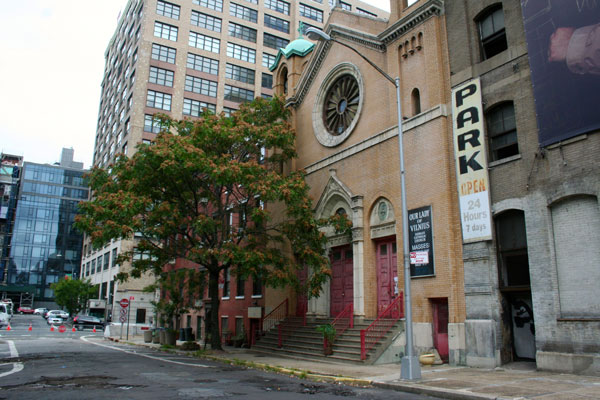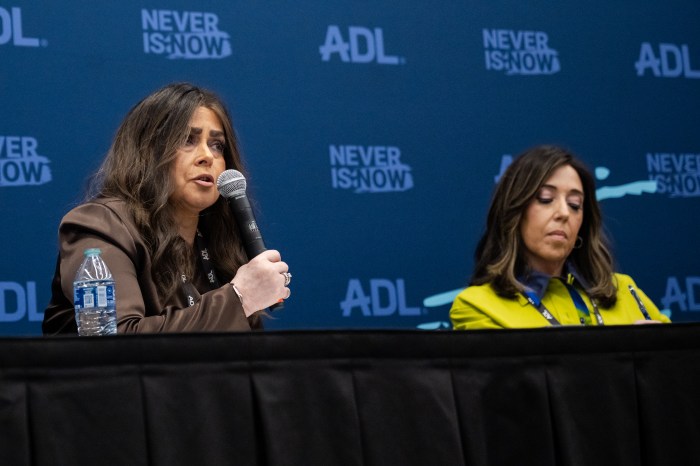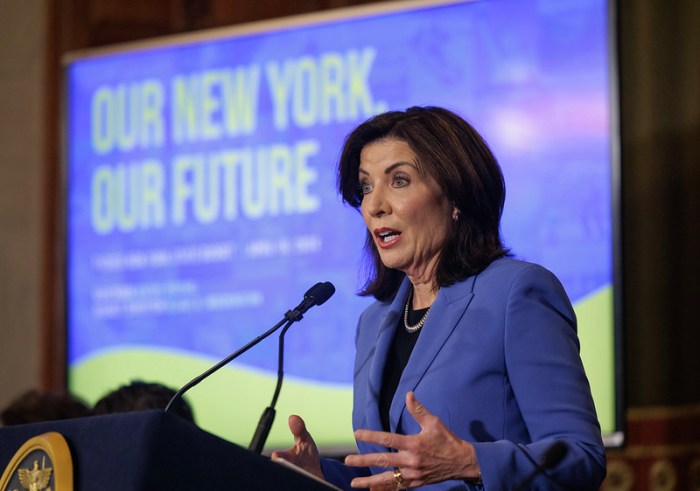
BY YANNIC RACK | A pending permit application could see another church bulldozed for luxury residences, after loyal parishioners have prayed on the steps of the church since it was padlocked seven years ago.
Last month, a permit was filed with the Department of Buildings for an 18-story, 30-unit apartment building on the site of the century-old Our Lady of Vilnius Church, at 568-570 Broome St., as well as the neighboring brownstone at 572 Broome St.
The Catholic Archdiocese closed the church, next to the Holland Tunnel entrance, in 2007, citing a dwindling congregation and an unstable roof too costly to fix.
But a close-knit group of Lithuanians and other ex-parishioners won’t give up. The church was the city’s only national parish church for the Lithuanian Catholic community.
“I consider it like a terminally ill family member and I am going to sit at the bedside until the bitter end,” said Christina Nakraseive, who blogs about Our Lady of Vilnius and is the vice chairperson of the committee to save the church.
“It’s been endangered since 2006 and even though we weren’t successful in court, I guess we were able to put off what was inevitable for a long time. But now that it seems to be coming to demolition, it’s really very painful,” she said on the phone, audibly tearing up.
Most Sundays, summer and winter, a group holds prayer services on the small steps in front of the yellow brick church, even though their priest is long gone.
On any other day, the only thing giving away the church’s fate are the Buildings Department notices tacked to the front doors, whose red paint has faded.
The former congregation has fought hard to reopen their church since it was abruptly shuttered by then-Archbishop Edward Egan.
“After they closed it, we found an application for a demolition permit, and in December 2007 we began to contest this demolition based on New York State religious corporation law,” Nakraseive explained.
The lawsuit went all the way to the Court of Appeals in Albany — the state’s highest court — but was ultimately defeated in 2011. Not even a direct appeal from Lithuania’s president to Pope Benedict XVI could save the church, much less a 4,000-signature petition to the archdiocese and a landmarking application.
“Sunday and Holy Day Masses were regularly attended by six to 30 persons,” read a letter from the archdiocese from the day the church was closed. “They were in English, inasmuch as the priest serving the parish for many years does not understand, read, or speak Lithuanian.
“There have been virtually no weddings or funerals in the church for years. Moreover, persons wishing to participate in Mass and parish activities in Lithuanian are informed of Lithuanian parishes in the neighboring Diocese of Brooklyn and Archdiocese of Newark.”
But Mindaugas “Gus” Blaudziunas, who went to the church since the early ’90s, said it experienced an influx of young people toward the end. He said that, at the time of closure, the parish membership list counted 395 persons, including Italians and Hispanics living in the area, as well as other non-Lithuanians.
At the end, only the basement was still open for services. The church’s main hall had been inaccessible for years because of a damaged roof support beam.
To the argument that there were no funerals or weddings anymore, he asked, “How can we do that in the basement?”
Nakraseive, whose grandparents were among the church’s first parishioners at the beginning of the last century, said she has dim memories of going to the church as a small child, attending Easter Mass and funerals.
Blaudziunas doesn’t see a way to stop the impending demolition.
“We’ve done a lot but now the church is in the hands of private people,” he said. “It’s a different situation.”
The New York Post reported that the church was sold to Extell Development for $13 million last year. Extell then flipped the property to the current owners, SoHo Broome Condos LLC, for $18.4 million earlier this year, according to New York YIMBY, a real estate Web site.
The developer listed on the building permit, KSK Construction Group, filed plans for the 60,800-square foot project through architects Builtd. New York YIMBY reported that the new owner bought the small walk-up next to the church for $12.3 million.
The Web site also mentioned that the project will not have an affordable component under the Hudson Square rezoning, since “the one-third density bonus [which would raise the F.A.R., or floor-area ratio, from nine to 12] is not enough to compel the developer to participate in the inclusionary housing program.”
“I think one of the things that I find hurtful, questionable, is that they’re selling the properties and it’s not like they’re building affordable housing. Where does the money go?” said Elaine Derso, the chairperson of the Save Our Lady of Vilnius Committee.
Extell also bought the former rectory at 32 Dominick St., behind the church, although the building was landmarked two years ago along with 34 and 36 Dominick St. The rectory is now listed for sale as a single-family townhouse with Douglas Elliman Real Estate.
Blaudziunas said the church’s function went beyond religious services.
“We used to have a lot of events in the basement there — artists, musicians, you name it — and especially for younger people, because there’s no other place to gather,” he said.
“Why could we not keep our community center? They said the Hudson Square development would revitalize the area,” he said, referring to the rezoning of the Hudson Square, the area above Canal St. and west of Sixth Ave., in 2013 to allow more residential use, a move he spoke out against at a City Council hearing at the time.
“If the application is submitted, of course it will be approved. So we just need to somehow say goodbye to our effort and the history of our community… . But we’re still thinking because you never know. It’s still standing after seven-plus years, so it’s already a miracle.”
However, Derso said the committee still has some fight left.
“We’re in the process of making some plans, I’m not sure exactly when or when,” she said. “But we figure, if the building is gonna go out with a bang, so should we!”
Blaudziunas noted, however, that the committee has not been active since the civil court case was lost in 2011. He said a Save Our Lady of Vilnius Initiative includes him and six other members, among them Rita Stelmokiene, who also leads the prayers on the church’s steps. Their goal, Blaudziunas said, is to “save and reuse the building as a historic site of Lithuanian national heritage.”
Blaudziunas said the longtime owner of the building next door to the church was another ex-parishioner and only sold after the offers became irresistible.
“It seems part of this wholesale transformation of New York by the real estate market,” said Nakraseive.
The church was completed in 1910, built by Lithuanian longshoremen and their families who lived in the area before the tunnel’s construction in the ’20s uprooted them, seeing them resettle in the Bronx and suburbs.
Nakraseive said she is also worried for other parishes because it seems “it’s all of the small, closely knit ethnic churches that the archdiocese is seeking to close.”
Cardinal Dolan recently pushed back to late October his announcement of the next wave of church mergers and closures.
The archdiocese is closing churches to consolidate underused houses of worship in an initiative called “Making all things new.” One of those at risk of demolition is the Garment District’s Church of the Holy Innocents, the city’s last church offering Mass in Latin.
“I call it ‘Making all things condo,’ ” Derso said bitterly.
















